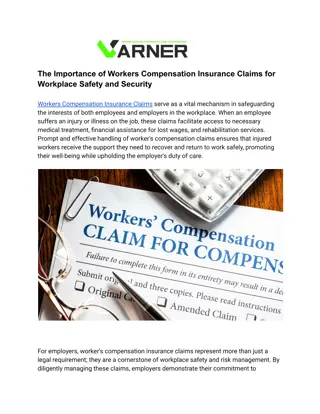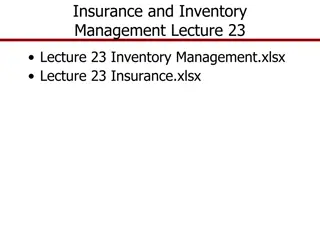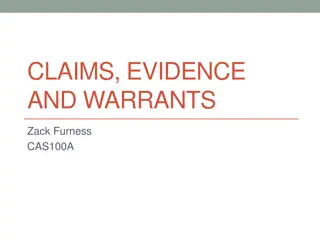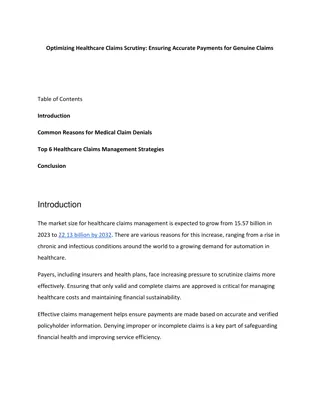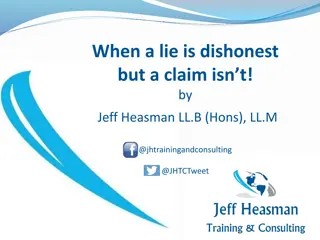Understanding Insurance Claims: A Comprehensive Guide
Businesses may face losses due to various reasons such as fire, theft, or flood, leading them to file insurance claims for compensation. This guide by Prof. Rupa Chandrashekhar More explores the meaning of insurance claims, types of claims (including asset and stock losses), and procedures for calculating losses when proper records are not available.
Download Presentation

Please find below an Image/Link to download the presentation.
The content on the website is provided AS IS for your information and personal use only. It may not be sold, licensed, or shared on other websites without obtaining consent from the author. Download presentation by click this link. If you encounter any issues during the download, it is possible that the publisher has removed the file from their server.
E N D
Presentation Transcript
Insurance Claim Accounts Prof. Rupa Chandrashekhar More
Introduction A Business may suffer abnormal losses due to different reasons such as fire, theft, flood, strike etc. A business concern is always faced with heavy loss due to fire and as a result the business activities are paralysed. Therefore, as a safety measure against such a probable loss, the business concerns generally take a fire insurance policy. Prof. Rupa C. More 2
Meaning When a business suffers a loss from an insured event, it has to notify the insurance company regarding the loss and to file a claim for compensation against those losses. Such claims are known as Insurance Claims. Prof. Rupa C. More 3
Types of Insurance claim Claim for Loss of Fixed Asset Claim for Loss of Stock Claim for Loss of Profit Prof. Rupa C. More 4
A) Claim for Loss of Asset When a fixed asset is destroyed, the computation of loss is simple. The value of such assets on the date of fire can be ascertained from the books of accounts because usually business concern maintains proper records of fixed assets. Fixed assets are recorded in the books of accounts at their acquisition cost. The claim for loss of assets can be calculated easily. Prof. Rupa C. More 5
B) Claim for Loss of Stock When a stock is destroyed, the computation of loss is not simple because the prices of different items of stock are seldom stable and the stock is acquired at varying rates. Unless there is a perpetual inventory system, there is no record of stock available in the books of accounts. At the end of the year the stock on hand is actually counted, valued and recorded. As such, if goods are burnt by fire some time during the year, the value of stock can not made available from the records. Therefore, the stock on the date of fire is required to be estimated. Prof. Rupa C. More 6
Procedure for Calculation When proper records are not available , the following steps is followed to ascertain the value of stock on the date of fire. Step I. Find out the percentage of Gross Profit on sales for the previous year by preparing the Trading Account of the previous year. * If percentage of Gross profit for number of past years is available, an average Percentage is to be taken. Prof. Rupa C. More 7
Format of Trading Account Trading Account for the period ended...... Cr. Dr. Particulars Amount (Rs.) Particulars Amount (Rs.) To Opening Stock To Purchases Less : Return Outward To Direct Expenses To Carriage and Freight Inward To Wages To Gross Profit * (Balancing Figure) By Sales Less : Returns Inward By Closing Stock Prof. Rupa C. More 8
Calculation of Percentage of Gross Profit to Sales If Sales = 100 then Gross Profit = ? Then formula is :- % of GP = Gross Profit 100 Sales Prof. Rupa C. More 9
Step II. Find out the value of the stock on the date of fire by constructing a separate Memorandum Trading Account : Memorandum Trading Account From 1stday of accounting year to the date of fire .. Dr. Cr. Particulars Amount (Rs.) Particulars Amount (Rs.) To Opening Stock To Purchases Less : Return Outward To Direct Expenses To Carriage and Freight Inward To Wages To Gross Profit (% on Sales) By Sales Less : Returns Inward By Stock on the date of fire (Balancing Figure) * Prof. Rupa C. More 10
Step III. Claim for Loss of Stock Statement showing Claim for Loss of Stock Particulars Stock on the date of fire ( As per Memorandum Trading Account) Less : Stock Salvaged (-) ( Retained / Saved by the business) Loss of Stock ( Claim to be Lodged)* Amount (Rs.) XXX XXX XXX * Subject to Average Clause. Prof. Rupa C. More 11
Average Clause Average Clause applies in case of under insurance. i.e. it is applicable when the amount of insurance policy is less than the value of stock on the date of fire. Average clause means the claim for the loss of stock is proportionately reduced having regard to under insurance of stock. The insured gets only proportionate amount of loss, based on the ratio of sum(amount) insured to total stock on the date of fire. Prof. Rupa C. More 12
Formula : To find out Claim Amount under Average clause Claim = Value of Insurance Policy X Loss of Stock Value of Stock on the date of fire Suppose, the stock on the date of fire is Rs. 60,000 . The sum insured is Rs. 48,000. The actual loss of stock after stock salvaged is Rs.40,000. then Claim for loss of stock will be : Claim = 48,000 X 40,000 60,000 = Rs. 32,000 Prof. Rupa C. More 13
Under or Over Valuation of Stock If the values of stock given in the problem are not at cost price and are under (below) or above (over) cost, valuation of stock must be made more accurately as per accounting principles. It is necessary to convert them to cost price before calculating the percentage of gross profit. Prof. Rupa C. More 14
Treatment of Abnormal Items of Goods The Gross Profit percentage gets disturbed due to existence of abnormal items. Abnormal items means items which do not carry the normal price tag due to the reasons that they are defective or of poor quality, or slow moving items etc. Such items are therefore, required to be separated from other normal items so we get the correct gross profit percentage. Cont. Prof. Rupa C. More 15
To determine the normal rate of gross profit, the stock and sales of these abnormal items are to be eliminated from the total sales and stock. Trading account is prepared for goods of normal items to ascertain accurate percentage of Gross Profit. Prof. Rupa C. More 16
C) Claim for Loss of Profit When a fire occurs, it not only destroys its assets but also dislocates the normal working conditions for sometimes. Due to fire the activities of the business are paralysed, the sales of the business are affected. As a result of reduction in sales the profit is also reduced. Prof. Rupa C. More 17
However, reduction in sales does not reduce the standing or fixed expenses of the business as they are required to be incurred as before. Therefore a business concern takes a Loss of Profit Policy which covers the risk against such losses. Loss of Profit Policy covers loss of gross profit sustained as a consequence of a business interruption. Prof. Rupa C. More 18
Important Terms Dislocation Period :- it is a actual period. During this period, the sales are comparatively less than what they are supposed to be under normal working conditions. Indemnity Period :- The Period during which the sales are expected to be affected due to fire is stated in the policy. This period is known as Indemnity Period . Prof. Rupa C. More 19
Short Sales :- is a reduced sales during the period of indemnity or period of dislocations whichever is less. Rate of Gross Profit :- the rate of gross profit earned on the turnover during the financial year immediately before the date of the damage (fire). Annual Turnover : - the turnover during the twelve months immediately before the date of the damage (fire). Prof. Rupa C. More 20
Standing or Fixed Charges :- these are expenses required to be incurred irrespective of the fact whether business activities are suspended or not. E.g. Rent, Rates & taxes, wages of skilled workers, Salaries of permanent staff, Director s fees, interest on loan, Auditor s fees etc. Prof. Rupa C. More 21
Steps for working out / Calculation of claim Step - I Calculation of Short Sales Particulars Amount (Rs.) XXX Sales during the corresponding period of dislocation or indemnity of the previous year Add : Expected percentage increase during the current year (+) XXX XXX XXX XXX Estimated or Expected Sales Less : Actual sales during the indemnity period or dislocation period (-) Short Sales Prof. Rupa C. More 22
Step II Calculation of the Gross Profit Percentage ( Rate of G.P.) Gross Profit % = Net profit + Insured standing charges X 100 Sales during the previous year Step III Calculation of Loss of Profit (Gross Claim) Loss of profit ( Gross Claim) = Percentage of Gross Profit X Short Sales Prof. Rupa C. More 23
Step IV Calculation of insurance cover required Insurance cover required = Gross profit X Sales ( Turnover) for the 12 months ending on the date of fire (+ Adjusted for expected increase, if any) Step V Application of Average Clause When the insurance policy taken is less than insurance cover required, then there is a case of under insurance, which attracts the application of average clause. Claim = Insurance Policy X Loss of Profit ( Gross Claim) Insurance Cover Required Prof. Rupa C. More 24
Thank You. Prof. Rupa C. More 25



